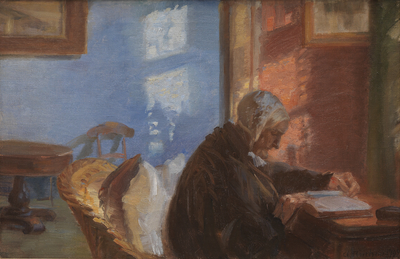Javascript must be enabled to continue!
The Artist's Mother Ane Hedvig Brøndum in the Blue Room
View through Europeana Collections
In The Artist's Mother Ane Hedvig Brøndum in the Blue Room, many of the defining traits of Anna Ancher’s painting after 1900 convene: Her endeavour to liberate colour and light, the emphasis on the picture plane rather than illusionistic depth, and not least her interest in constructive elements which can be seen in the cropping of the two columns of light reflexes. As in other interieurs, the room is dense with objects; however all things – from the old mother to the table, chairs, and paintings on the walls – have been subordinated to the coloristic effect of the whole. Along with Theodor Philipsen (1840-1920), Anna Ancher is regarded as the most important Impressionistic painter on the Danish art scene. But whereas the French Impressionists were intimately linked with modern life, Anna Ancher painted her pictures on the outskirts of the modern: from Skagen, the remotest part of Denmark, more opposed to than in tune with the hectic and the ephemeral.
Title: The Artist's Mother Ane Hedvig Brøndum in the Blue Room
Description:
In The Artist's Mother Ane Hedvig Brøndum in the Blue Room, many of the defining traits of Anna Ancher’s painting after 1900 convene: Her endeavour to liberate colour and light, the emphasis on the picture plane rather than illusionistic depth, and not least her interest in constructive elements which can be seen in the cropping of the two columns of light reflexes.
As in other interieurs, the room is dense with objects; however all things – from the old mother to the table, chairs, and paintings on the walls – have been subordinated to the coloristic effect of the whole.
Along with Theodor Philipsen (1840-1920), Anna Ancher is regarded as the most important Impressionistic painter on the Danish art scene.
But whereas the French Impressionists were intimately linked with modern life, Anna Ancher painted her pictures on the outskirts of the modern: from Skagen, the remotest part of Denmark, more opposed to than in tune with the hectic and the ephemeral.
Related Results
Hedvig Elisabet Charlotta (1759-1818), prinsessa av Holstein-Gottorp, drottning av Sverige och Norge
Hedvig Elisabet Charlotta (1759-1818), prinsessa av Holstein-Gottorp, drottning av Sverige och Norge
New acquisition, March 2012 Hedvig Elisabet Charlotta, by Johan Tobias Sergel: When Johan Tobias Sergel was recalled to Sweden from Rome by King Gustav III, the sculptor hoped to b...
The Painter Ane Marie Hansen
The Painter Ane Marie Hansen
An interior is a fitting symbol of the space allowed for female artists; they were quite limited in terms of both their social life and what was considered suitable subject matter ...
Mother and Child
Mother and Child
Renoir once quipped that had God not created the female breast, he might never have become an artist. Indeed, the full, womanly bosom figures prominently in Renoir's loving portray...
Woman at the Window
Woman at the Window
The nineteenth century witnessed the evolution of the nuclear family unit—father, mother, and children—into a nexus of bourgeois social life throughout Europe and North America. In...
Breechcloth
Breechcloth
Breechcloth; probably Yanktonai; 1860-1870Wool, porcupine quills, sinew, metal, horsehair, pigments; 117.5 x 28.5 cm.\RMV 710-9; Herman F.C. ten Kate collection; purchased from tra...
Porcelain cane handle, painted in underglaze blue, made by Saint-Cloud porcelain factory, France, about 1700-1750. Porcelain cane handle with lobed bulbous knop, painted with formal ornament and the end with a cut sprig in underglaze blue. Soft-paste por
Porcelain cane handle, painted in underglaze blue, made by Saint-Cloud porcelain factory, France, about 1700-1750. Porcelain cane handle with lobed bulbous knop, painted with formal ornament and the end with a cut sprig in underglaze blue. Soft-paste por
Porcelain cane handle, painted in underglaze blue, made by Saint-Cloud porcelain factory, France, about 1700-1750. Porcelain cane handle with lobed bulbous knop, painted with forma...
Cane handle, porcelain, painted in underglaze blue, Saint-Cloud porcelain factory, France, about 1700-1750. Cane handle, porcelain, painted in underglaze blue. Plain bulbous knop, painted with formal ornament and the end with a cut sprig. Soft-paste porc
Cane handle, porcelain, painted in underglaze blue, Saint-Cloud porcelain factory, France, about 1700-1750. Cane handle, porcelain, painted in underglaze blue. Plain bulbous knop, painted with formal ornament and the end with a cut sprig. Soft-paste porc
Cane handle, porcelain, painted in underglaze blue, Saint-Cloud porcelain factory, France, about 1700-1750. Cane handle, porcelain, painted in underglaze blue. Plain bulbous knop, ...
Looped Textile Square: Quail
Looped Textile Square: Quail
Panel from a linen cloth faced with long loops of linen thread. The inwoven slit tapestry square (tabula) introduces wool wefts. At center, a quail with red feet and beak sits with...




